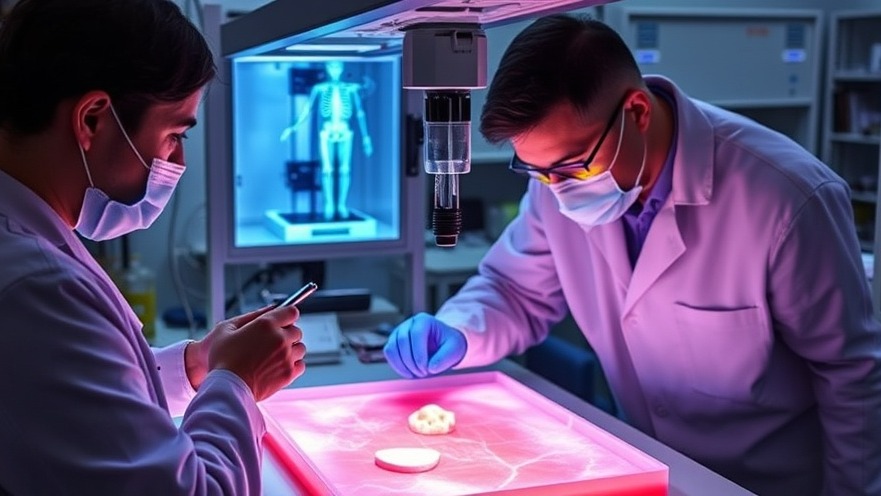
3D-Printed Grafts: A New Era in Bone and Tissue Regeneration
Over the past decade, 3D printing has evolved from a futuristic concept to a transformative medical technology, especially in the fields of bone and tissue regeneration. As we progress into the future, the implications of 3D-printed grafts are becoming increasingly pivotal in surgeries involving bone defects caused by accidents, cancer, or congenital conditions.
Understanding 3D Printing in Medicine
Known technically as additive manufacturing, 3D printing allows for the creation of intricate medical structures tailored to individual patient needs. This method constructs objects layer by layer based on sophisticated digital models. In clinical settings, 3D printing is commonly utilized to develop inert implants and prosthetics; however, its application is expanding into the realm of living tissues through a breakthrough process called bioprinting.
Bioprinting: The Cutting Edge of Tissue Engineering
Bioprinting represents a revolutionary advance in regenerative medicine. This innovative process involves creating scaffolds embedded with the patient's cells, fostering an environment that promotes natural growth and healing. By aligning the material's properties with the body’s biological needs, the process decreases the likelihood of rejection and enhances healing speed. Imagine a scenario where clinicians can eventually create full organs for transplant, effectively addressing the global shortage of donor organs. The possibilities are vast, and research is moving forward rapidly.
Promising Developments in Europe
The vast potential of bioprinting is particularly evident in Europe, where pioneering research is addressing the complexities of healing large or intricate bone defects. Traditional bone grafts often struggle to support vascular growth, which is critical to healing. However, advances in technology and materials are changing this dynamic.
For example, researchers at the Institute for Bioengineering of Catalonia (IBEC) have developed 3D-printed scaffolds composed of polylactic acid and calcium phosphate. These materials not only support bone growth but also promote the formation of blood vessels, as shown in both laboratory and animal studies. In these tests, scaffolds demonstrated effectiveness in encouraging stem cell proliferation and the release of vital growth factors, successfully attracting necessary blood vessels to aid in recovery.
The Role of Patient-Centric Design
At the University of Bergen, initiatives focusing on personalized medicine are underway. The Tissue Engineering Group's projects focus on utilizing a patient's own stem cells to produce custom bone replacements. This tailored approach reduces rejection risks and leads to better recovery trajectories. The European Union’s Smart Bone Regeneration (SBR) project is also innovating in this space by developing smart implants designed for rapid bone restoration.
Implications for Concierge Health Practitioners
As concierge health practitioners, staying informed about these advancements is crucial as they can directly influence patient outcomes. The integration of 3D-printed grafts into clinical practice could revolutionize treatment options and improve the quality of care. Embracing emerging technologies not only enhances surgical precision but also maximizes recovery through innovative patient-centered strategies.
Looking Ahead: Unlocking Future Possibilities
While we are on the cusp of astounding breakthroughs in bone and tissue regeneration with 3D printing, it's essential for healthcare practitioners to understand the operational implications of these technologies. Consider how the use of bioprinted scaffolds can streamline surgical procedures and potentially decrease recovery times.
This knowledge equips practitioners to make informed decisions on adopting new technologies and treatments in their practice, thereby ensuring they are at the forefront of medical innovation.
As this technology matures, practitioners will be better positioned to underserved populations by offering solutions that were previously unimaginable. Investing in knowledge now can lead to better examples of healthcare in the near future.
Act Now to Transform Patient Care
In conclusion, keeping abreast of developments in 3D-printed grafts and bioprinting is not just beneficial but essential for concierge health practitioners. By understanding these trends, you can better serve your patients and remain a leading figure in the ever-evolving landscape of healthcare technology.
Stay updated on technological advancements to transform what’s possible in patient care.
 Add Row
Add Row  Add
Add 




Write A Comment